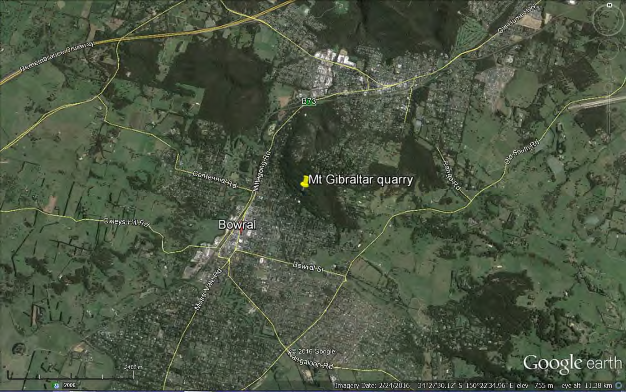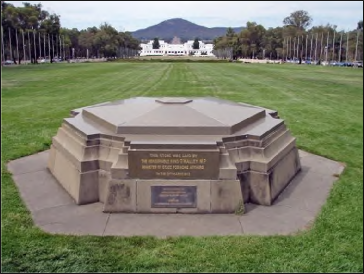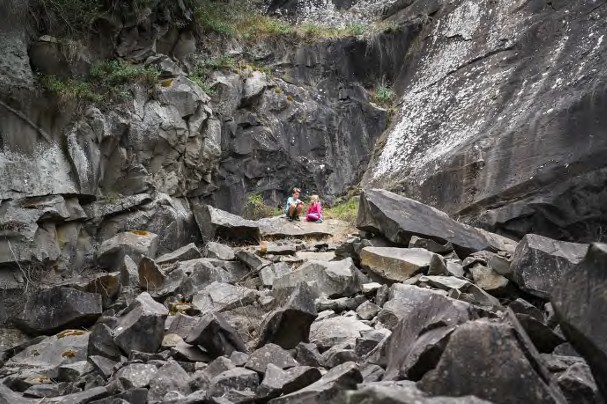
Introduction
Mount Gibraltar is a prominent rock mountain between Mittagong and Bowral in the southern highlands of NSW, about 118 km southwest of Sydney. The rock is termed a microsyenite. It is a syenite because it is grey igneous rock composed mainly of alkali feldspar and Fe-Mg minerals such as hornblende, biotite and augite and it is a microsyenite because it is a medium-grained igneous rock, whereas a classic syenite is more coarse-grained.

The particular rock which was quarried on Mount Gibraltar for 100 years, from 1886 to 1986, was given the common name of Bowral trachyte. This stone was used to build many grand public buildings.

Geological overview
The Mount Gibraltar Microsyenite is a small alkaline igneous intrusive body (the term ‘alkaline’ means relatively enriched in sodium and potassium) emplaced into the flat-lying beds of the Triassic Hawkesbury Sandstone during the Jurassic time period, so the formation of the rock is dated at 178 million years ago. The volume of the magma which intruded the sediments caused the Hawkesbury Sandstone and overlying Wianamatta Shale to buckle upward, but the magma did not breach the surface, and it cooled slowly under the ground.

The major escarpment on the western side of the mountain is interpreted to be a vertical fault. After large amounts (estimated at approximately 4 km) of the sediments were eroded away by rain and wind, the hard microsyenite was progressively exposed on the surface of the land, eventually creating the prominent mountain seen today. The sequence of major events is shown above in the drawing from the publication Mount Gibraltar Heritage Reserve.
The Mount Gibraltar Microsyenite provides a rare example of a rock that contains siderite occurring as a member of a magmatic mineral assemblage. Siderite is an iron carbonate mineral (FeCO3) usually found in sedimentary rocks and other low temperature environments of formation, not in a hot magma. The presence of the (reddish-coloured) crystals of siderite reveals information about the chemistry, temperature, pressure and depth of burial of the molten magma that slowly cooled to form the microsyenite.
DID YOU KNOW?
The Mount Gibraltar Microsyenite is just one many igneous rocks intruded into the crust of Eastern Australia during the Jurassic. We have many others including the Tasmanian representative in the Federation Rocks, a Jurassic dolerite. This widespread magmatic activity was a prelude to the breakup of the supercontinent of Gondwana over the following 100 million years.
Indigenous context
The Mount Gibraltar area was home to the Gundungurra people (The Mountain People) and borders Dharawal country which extends eastward to the coast. These people moved around the land in small groups, according to the season, following food gathering opportunities and coming together with other groups according to their social and customary arrangements. The mountain has cultural significance for both peoples. It is thought that Gundungurra people or their forebears could have inhabited this area for 40,000 years.
The summit of Mount Gibraltar would have been a useful point for sending and receiving messages. Many Aboriginal words are still in use locally, including the name of the Council, Wingecarribee. In the Reserve grow many of the plants that were used by Gundungurra people for food, bedding, medicine, implement-making and ceremonial purposes.
After the arrival of white settlers, Aboriginal numbers dropped dramatically from land displacement, disease, change of diet and interruption of their way of life, a terrible outcome of white settlement in the Southern Highlands.
Modern history
The first European exploration of the southern highlands was led by John Wilson in 1798. Cattle were introduced in 1816. Charles Throsby became the first European settler in 1819 on a 1,000 acre land grant east of Moss Vale. While surveying roads in the area in 1852, Major Thomas Mitchell recorded the presence of good quality building stone which he called ‘whinestone’ – an old name for microsyenite.

DID YOU KNOW?
That Mount Gibraltar Microsyenite has been watching the world go by on busy George Street, Sydney for over a 100 hundred years, from the time of horse-drawn carriages to today’s light rail. But what seems a long time in human history is only a blink of an eye in the story of this rock, it is less than one millionth of the time it has been around.
Quarrying of this rock commenced at Mount Gibraltar in 1886. Jane Lemann describes the historic developments of various operations in Chapter 6 Trachyte Quarries of Mount Gibraltar in the excellent book The Gib. Mount Gibraltar, Southern Highlands published by Mount Gibraltar Landcare & Bushcare and Wingecarribee Shire Council in 2007. This document contains images of several quarry operations, and provides a detailed account of the many uses of this rock.


DID YOU KNOW?
Mount Gibraltar Microsyenite was used in the Canberra Foundation Stone, laid down at a ceremony on 12 March 1913 to designate the official foundation of the national capital and its naming as Canberra. This hexagonal base of six rock blocks represents the six colonies at the time and was intended to support an 8-metre high column to signify the Commonwealth, but the column was never built!
The Canberra Foundation Stone had been originally sited on Capital Hill, located where new Parliament House now sits. Seventy five years later, on the 12 March 1988, another ceremony was held to mark the moving of the stones to their present location, on the lawns in front of Old Parliament House, attended by the Governor General, the Prime Minister and the Minister for the Arts and Territories.

To conclude this section, it is appropriate to re-state Lemann’s quotation of the opinion of curator, author and scientist, R. T. Baker, in 1909 as follows: ‘This really beautiful stone of unique colour, which may be described as dark olive green, or perhaps dark grey, is very solid and takes a beautiful polish Some of the finest architectural structures in Sydney are built of this rock’.
About the NRG specimen
The NRG specimen was collected from the Mount Gibraltar quarry shown in the image below.

The image below shows uplift of the eleven tonne rock which Wingecarribee Shire Council, the owner of the quarry, donated to the National Rock Garden, for placement in a secure facility open to the Australian public in perpetuity.

After funds were raised to cover the costs of the shipment from Bowral to the ACT, the rocks were placed on a truck and placed next to the NRG’s Federation Rocks in Canberra on 1 November 2017.

A formal public promotion of the placement of this rock was conducted at the NRG site on 25 March 2018, commencing with a Welcome to Country by Tyronne Bell. The supporters of the Rock Garden were addressed by Ken Halstead, Mayor of Wingiecarribee Shire Council, and also by historian Jane Lemann, ACT Councillor Elizabeth Lee and NRG Chair Brad Pillans.

Heritage protection
Mount Gibraltar Reserve was listed by the NSW Heritage Council on its Significant Heritage Register in December 2013, both for its Endangered Ecological Communities and the Heritage Quarries Complex. The forest was listed in November 2011, under the Australian Government’s Environment Protection and Biodiversity Conservation Act as being part of the endangered ‘Uplands Basalt Eucalypt Forests of the Sydney Basin Bio-region’ following a similar listing under the NSW Threatened Species Conservation Act in 2001 as ‘Mount Gibraltar Forest’. In 2008 The NSW National Trust added the Mount Gibraltar Quarries Complex to its Industrial Heritage List. The Reserve was registered with Land for Wildlife in 2014.
Tourism
The Mt Gibraltar Reserve is a popular tourist destination. A Visitors Guide for the Reserve is available at: http://121.50.208.46/southernhighlands/Mt%20Gibraltar.pdf.
Wingecarribee Shire Council provides good information about the Reserve at its website https://www.wsc.nsw.gov.au/Facilities/Parks/Mount-Gibraltar-Heritage-Reserve
Mount Gibraltar Bushcare and Landcare Group
The acquisition was enthusiastically supported by the Mount Gibraltar Bushcare and Landcare Group, which wrote to the mayor of Wingecarribee Shire Council in favour of a specimen being provided to the NRG, and which contributed to the cost of transporting the rock to Canberra. This group delivers planning advice to Council, and undertakes regular weed management, bush regeneration and track maintenance within the Mount Gibraltar Reserve (See https://landcare.nsw.gov.au/groups/mt-gibraltar-bushcare-and- landcare/).
The group has published the informative 16-page booklet “Mount Gibraltar Heritage Reserve” and in 2007, the group published a magnificent 163-page hardcover book entitled: The Gib. Mount Gibraltar, Southern Highlands.
Mount Gibraltar is still recognised as a special place just as it was in the deep time of the indigenous past.
Acknowledgements
On 4 November 2016, Wingecarribee Shire Council’s Deputy General Manager Mark Pepping advised the NRG that Council approved the donation of an agreed rock specimen to the NRG (with funding for transport to be obtained by the NRG).
The NRG Steering Committee is very pleased to acknowledge the support of the Mount Gibraltar Bushcare and Landcare Group which provided a grant of $2,000 and the Veolia Mulwaree Trust which provided the NRG with a grant of $1,000. These amounts together covered the transportation costs and the preparation of the specimen for display.
Want to know more?
Lemann, J., Simons, J., Smith, E., Wright, C., Moffatt, J.-R. and Elphick, M. (Eds.), 2007. The Gib.: Mount Gibraltar, Southern Highlands. Mount Gibraltar Landcare & Bushcare and Wingecarribee Shire Council, Bowral, 263 pp.
Heritage aspects: https://landcare.nsw.gov.au/groups/mt-gibraltar-bushcare-and- landcare/booklets/mount-gibraltar-heritage-reserve/
Canberra’s Foundation Stone: https://www.sydney-australia.biz/act/places/foundationstone.php See also: https://ramblingwombat.wordpress.com/2017/05/27/foundation-stone-what-is-it/
Graham, I., 2018. Classification of igneous rocks. Australian Museum website. Last accessed 3 August 2022. https://australian.museum/learn/minerals/shaping- earth/classification-of-igneous-rocks/
Andersen, T., Carr, P. and Erambert, M., 2012. Late-magmatic mineral assemblages with siderite and zirconian pyroxene and amphibole in the anorogenic Mt Gibraltar microsyenite, New South Wales, Australia, and their petrological implications. Lithos, 151 46–56. https://doi.org/10.1016/j.lithos.2011.09.012



